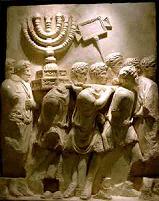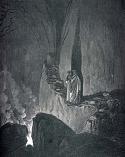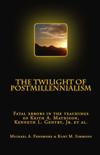Preston- V -Simmons
When Was Sin Defeated? AD 70 or the Cross?
Simmons' First Affirmative
Simmons' First Affirmative
It is my turn to be in the affirmative. Here is
the proposition I will affirm:
Resolved:
The Bible teaches that the coming of Christ for salvation in Romans
Here are the
definitions I will employ:
“Coming” refers to the first advent of Christ, from
his nativity to his ascension.
“Cross” includes the death, burial, and resurrection
of our Lord. “Salvation” signifies the work of atonement
accomplished in Jesus’ substitutionary death. “Climax and
termination of the Mosaic Covenant Age” refers to the legal end and
annulment of the covenant enjoined by Moses in the wilderness.
Don and I are both
agreed that “salvation” in the passage refers to salvation from
sin. In my
negatives, I have already proved that the debt of sin was paid and
expunged, and that grace was full and free from and after the cross.
But if salvation from sin occurred at the cross, it
then follows that the coming contemplated by the passage also
refers to the cross.
Thus, proof of one is proof of the other.
Moreover, proof that the bondage of sin was broken and men
were fully justified in the death, burial, and resurrection of
Christ also proves that the Old Testament was annulled.
As long as the Old Covenant was in force, men were under
bondage to sin. But
beginning with the gospel, forgiveness of sins in the death of
Christ was announced. It thus follows that the Old Testament was not
in force or effect from and after Jesus’ cross.
Reduced to a syllogism, the argument might be expressed thus:
The way into the
Holiest was not open while the first tabernacle (the Old Testament)
had legal standing (Heb. 9:8).
But the Holiest was
a figure for the New Testament (Heb. 9:9).
The New Testament
became of force at Jesus’ death (Heb.
The way into the
Holiest was opened and the Old Testament (first tabernacle) lost
legal standing in Jesus’ death.
Moreover, we have
shown that it is impossible for there to be two concurrent,
conflicting covenants in force at the same time.
Therefore, proof that the New Testament was of force, ipso
facto proves that the Old Testament was annulled.
To the many verses we have already produced demonstrating
this fact, we would add that Dan. 9:27 states that the “sacrifice
and oblation” would cease in the midst of the final prophetic week,
and that this is traditionally held to signify the legal cessation
of the temple ritual by the death of Christ at the conclusion of his
three and half year ministry:
“On
the ordinary Christian interpretation, this applies to the
crucifixion of our Lord, which took place, according to the received
calculation, during the fourth year after his baptism by John, and
the consequent opening of his ministry.”[1]
Thus, proof that the
power of sin was broken and men were justified after the death,
burial and resurrection of Christ, also proves every other element
of my proposition, all of which we have already abundantly
demonstrated in the course of our negatives.
Therefore, we need not say or produce one proof more.
Our proposition stands confirmed:
The coming of
Christ for salvation from sin was accomplished in the cross at the
termination of the Mosaic covenant.
However, since we
promised that we could produce pages of verses showing that grace
and full and free, and that the Old Testament was therefore legally
annulled and taken out of the way at the cross, we will produce some
of those now and then lay down our pen.
The following are by no means exhaustive; many more could be
produced. Don ignored all
the verses we produced before.
Perhaps he would grace us with his attention to them now.
If not, we will consider Don to have surrendered his position
and this debate concluded in favor of Christ’s cross.
Romans
1:5 – “By whom we
have received grace.” Note the verb tense “have received.”
1:7 – “Grace to
you and peace from God our Father, and the Lord Jesus Christ.”
The gospel of Christ’s cross places man in a state of grace and
peace with God. AD 70 is nowhere in sight.
1:1, 15 – “I am
ready to preach the gospel (glad tidings)” The tidings are
gladsome because they carry the present assurance of grace.
Proof that the gospel was valid ipso facto proves the
Old Testament was invalid.
5:1 – “Therefore,
being justified by faith, we have peace with God through our Lord
Jesus Christ.”
5:2 – “By whom we
also have access by faith into this grace wherein we now stand.”
Here Paul affirms that the saints “now stand” in a state of grace
through the cross of Christ.
5:9 – “Much more
then, being now justified by his blood, we shall be saved from wrath
through him.”
Notice the verb tense, “being now justified.” What part of “now
justified” would Don deny?
6:7 – “He that
has died is freed from sin.”
The Christian “dies” with Christ in baptism; he is made a
participant in Jesus’ death, and is thus “freed from sin.”
7:1-4 –
“Wherefore, my brethren, ye also are become dead to the law by the
body of Christ.”
Don ignored these verses before.
They teach that the law of the first husband (Old Testament)
terminated with the death of Christ, so that we might enter a new
covenant (the gospel). These verses teach the same lesson as those
in Heb. 9 regarding the way into the Holiest by the sacrifice of
Christ. The one
covenant ends where the other begins.
7:6 – “But now we
are delivered from the law, that being dead wherein we were held.”
Note the verb tense: NOW DELIVERED FROM THE LAW.
8:1 – “There is
now no condemnation to them which are in Christ Jesus.” NOW NO
CONDEMNATION. What part
of “now” would Don deny?
8:2 – “For the law
of the Spirit of life in Christ Jesus hath made me free from the law
of sin and death.” HATH
MADE ME FREE FROM THE LAW.
Perfect tense, completed action in the past.
8:3, 4 – “God
condemned sin in the flesh [of Christ] that the righteousness of the
law might be fulfilled in us.” By Jesus’ death, the law of sin
and death was satisfied that God might acquit us.
10:4 – “Christ is
the end of the law for righteousness for every that believeth.”
END OF THE LAW.
Hebrews
1:3 – “When he
had by himself purged our sins, sat down on the right hand of the
Majesty on high.”
Note the verb tense “had purged our sins.”
Perfect tense, showing completed action in the past.
Christ “sat down” also shows the work of redemption was
complete.
2:14, 15 –
“Through death he might deliver them.”
It was in Jesus’ death that man was saved, not his second
coming.
8:6 – “But now he
hath obtained a more excellent ministry, by how much more he is the
mediator of a more excellent covenant.”
A MORE EXCELLENT COVENANT.
The New Testament supplanted the Old; the two could not be
valid simultaneously.
Christ’s priesthood replaced the Levitical priesthood, and his
Testament replaced the Old.
9:8 – “The Holy
Ghost this signifying, that the way into the holiest was not yet
made manifest, while as yet the first tabernacle was yet standing.”
No man could enter the Holy of Holies until the
atonement was complete.
But the Holy of Holies was a figure for the New
Testament and gospel.
The New Testament was of force from and after
the cross. Therefore,
The atonement was complete and man could enter
(legally and covenantally) the Holy of Holies from and after the
cross.
9:15 – “He is the
mediator of the new testament, that by means of death, for the
redemption of the transgressions under the first testament, they
which are called might receive the promise of eternal inheritance.”
This verse plainly shows that the New Testament was then in
force and provided redemption that could not obtain as long as the
Old Testament was valid.
10:9 – “When he
said, Lo, I come to do they will, O God. He taketh away the first,
that he may establish the second.” Here we see that the first
covenant was taken away at Christ’s first coming, not second.
The first had to be taken away that the second (New
Testament) could be established. Why? Because it is impossible both
be valid at the same time.
10:12 – “But this
man, after he had offered one sacrifice for sins for ever, sat sown
on the right had of God.”
That Christ “sat down” shows his work of atonement was
complete.
12:7, 8 – “God
dealeth with you as with sons.”
Sonship is predicated upon reconciliation and atonement.
Under the Old Testament men were deemed servants (Gal. 4:7;
Rom.
12:23 – “To the
general assembly and church of the firstborn, which are written in
heaven, and to God the Judge of all, and to the spirits of just men
made perfect.”
SPIRITS OF JUST MEN MADE PERFECT.
Notice that God “the Judge of all” is joined by the writer to
the justification of spirits in Hades.
Thus, God had acquitted them based upon reception of Christ’s
blood. The saints on
earth were numbered in the assembly of those justified.
13:20, 21 – “Now
the God of peace, that brought again from the dead our Lord Jesus,
that great shepherd of the sheep, through the blood of the
everlasting covenant, make you perfect in ever good work.”
The resurrection of Christ assumes his justification from the
imputation of sin he bore upon the cross.
We participate in Jesus’ death through baptism (
I Peter
1:2 – “Elect
according to the foreknowledge of God the Father, through
sanctification of the Spirit, unto obedience and sprinkling of the
blood of Jesus Christ: Grace unto you, and peace, be multiplied.”
Peter here assures the Gentile believers in
1:3 – “Blessed be
the God and Father of our Lord Jesus Christ, which according to his
abundant mercy hath begotten us again unto a lively hope by the
resurrection of Jesus Christ from the dead.”
The verb tense here is perfect, showing completed action in
the past. “Hath begotten us again.”
The new birth is predicated upon reconciliation and
atonement. The
resurrection of Christ is proof that justification was a present
fact.
1:18, 19 – Ye were
redeemed by “the
precious blood of Christ, as of a lamb without blemish and without
spot.” Verb tense
shows present possession of redemption. What part of “were redeemed”
would Don deny?
II Peter
1:2 – “Grace and
peace by multiplied unto you through the knowledge of God, and of
Jesus our Lord.”
Grace is the state of present reconciliation.
1:9 – “And hath
forgotten that he was purged from his old sins.”
Past tense – was purged from his old sins.
When? AD 70? No, AD 33 at the cross.
I John
2:2 – “He is the
propitiation of our sins: and not for ours only, but also for the
sins of the whole world.”
The word “propitiation” here is actually “mercy-seat” and
shows that Jesus’ sacrifice enters within the veil, coving the debt
of sin by the law.
Galatians
Gal. 2:4 –
“Because of false brethren unawares brought in, who came in privily
to spy out our liberty which we have in Christ Jesus, that hey might
bring us into bondage.”
The Judaizers, like Don, claimed that the law was still
binding, but Paul told the church not to submit to obey its demands.
Gal. 2:9 – “For I
through the law am dead to the law, that I might live unto God.”
By Christ’s atoning sacrifice, we are redeemed from the law
and become dead to its demands.
5:1 – “Stand fast
therefore in the liberty wherewith Christ hath made us free, and be
not entangled again with the yoke of bondage.”
If the law was valid as Don alleges, then Paul was under
serious misapprehension of the facts.
Colossians
2:9, 10 – “For in
him dwelleth all the fullness of the Godhead bodily. And ye are
complete in him, which is the head of all principality and power.”
“Complete” here has the sense of soteriological perfection.
In Christ the saints were complete, lacking nothing to make
them acceptable for salvation.
And when were they complete?
At AD 70? Of
course not. They were complete from and after the cross.
2:14 – “Blotting
out the handwriting of ordinances that was against us, which was
contrary to us, and took it out of the way, nailing it to the
cross.” The
“handwriting of ordinances” here is not the Ten Commandments as is
commonly supposed, but a memorandum, like a mortgage, reciting our
debt before the law.
When a man paid off his debt, it was nailed to the post of his door,
providing public evidence that he was freed of his former
obligation. So here,
Paul says Christ carried the debt of our sin to the cross, nailing
it there, showing publicly its cancellation in his death.
If Don were permitted to have his way, we would have to
rewrite this verse so that the debt was nailed to a Roman catapult
in the siege of AD 70!
Don’s Empty Boxes
|
Don’s Box No. 1
Verses? |
|
Don’s Box No. 2
Verses? |
|
Don’s Box No. 3 Commentators?
|
|
Don’s Box No. 4 Verses? |
Conclusion
Scripture abundantly
testifies to the fact that atonement was complete and justification
full and free from and after Jesus’ cross. But if salvation from sin
arrived at the cross, then the coming of Rom.
To receive Kurt Simmons’ e-mail newsletter, The Sword & The Plow, click the Subscribe link:
All rights reserved.






